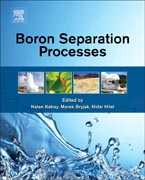
The impending crisis posed by water stress and poor sanitation represents one of the greatest human challenges for the 21st century, and membrane technology has emerged as a serious contender to confront the crisis on a global scale.For the first time, the reader will be able to see the contributions on boron separation processes in one reference work. For the laymen (non scientist-Why should he/she buy this book?) Overcoming the crisis in water and sanitation is one of the greatest human development challenges of the 21st century, according to a recent U.N. report. Membrane technology is a highly efficient and cost effective process to address this world-wide crisis. Boron issue is one of the target area to be solved in desalination plants where membrane technologies are employed to produce water for irrigation. Yet, whilst there are countless texts on water treatment and on membrane technologies, none address in a whole and integrated way the boron problem and separation processes for boron elimination. For the user (scientist/expert-why should he/she buy the book?) The book will provide a unique and single source in highlighting the growing and competitive importance of boron separation processes. For the first time, the reader will be able to see in one reference work the state of the art in this rapidly growing area. The book will focus on four main areas: Effect of boron on human and plants, Separation of boron by ion exchange and adsorption processes, Separation of Boron by membrane processes, Simulation and optimization studies for boron separation. The book will feature a wide array of topics covering this emerging and important technological area. The reader will be able to see in one reference work the state of the art in this rapidly evolving area. INDICE: Section 1 : Boron in the environment Chapter 1: Boron in the environment: Sources, speciation and bioeffect (F.S.Kot, Technion, Israel) Chapter 2: The Chemistry of boron in water (V.Kockodan-N.Hilal, Swansea University, UK) Chapter 3: Boron nutrition and boron application in crops (Lei Shi, Fangsen Xu, Huazhong Agricultural University, China) Chapter 4: The reproductive effects of boron on laboratory animals and humans (Y.Duydu, Ankara University, Turkey, N.Basaran, Hacettepe University, Turkey, H.M. Bolt, Leibniz Research Center for Working Environment and Human Factors, Germany) Section 2 : Removal of Boron by Ion Exchange and Adsorption Processes Chapter 5: Ion Exchange Borate Kinetics (Jidong Lou and Gary Foutch, Oklahoma University, USA) Chapter 6: Separation and recovery of boron from various resources using chelate adsorbents (K.Yoshizuka and S.Nishihama, The University of Kitakyushu, Japan) Chapter 7: Removal of boron by clays and minerals (T.Kozlecki, I.Polowczyk, Wroclaw University of Technology, Poland) Chapter 8: Design of new boron selective chelating resins and their application in PEUF (N.Biçak, Istanbul Technical University, Turkey, H. O. Ozbelge and Levent Yilmaz, Middle East Technical University, Turkey) Section 3: Boron Removal by Membrane Processes Chapter 9: Boron Removal Using Membranes (V.Freger, H.Shemer and R.Semiat, Technion, Israel) Chapter 10: Boron Removal from seawater and geothermal water using RO process (N.Kabay, Ege University, Turkey) Chapter 11: Boron Removal from water by hybrid processes (M.Bryjak, Wroclaw University of Technology, Poland, N.Kabay, Ege University, Turkey) Chapter 12: Boron Separation by ion exchange membranes (P.Dydo, M.Turek, Silesian University of Technology, Poland) Chapter 13: Boron Removal from Waste Water Originating from the Open Pit Mines of Bigadic Boron Work by means of Reverse Osmosis (M.V. Duman, ETI Maden Works, Turkey and E. Özmetin, Balikesir University, Turkey) Section 4: Simulation and Optimization Studies Chapter 14: Simulation and Optimization of Boron Removal in Full-Scale Reverse Osmosis Processes (Jae-Hong Kim, Georgia Institute of Technology, USA and Pyung-Kyu Park, Yonsei University, S.Korea) Chapter 15: Efficient single-pass boron removal approach: prospects and challenges (O.Nir and O. Lahav, Technion, Israel) Chapter 16: Boron Removal from Seawater Reverse Osmosis Permeate: Analysis of Current Technologies (A.Bick, Bick&Associates, Israel and G. Oron, Ben Gurion University, Israel) Chapter 17: Hybrid adsorption-microfiltration process with plug flow of microparticulate adsorbent (M. Blahusiak, and S.Schlosser, Slovak University of Technology, Slovakia) Chapter 18: Boron uptake from aqueous solution by chelating adsorbents: A statistical experimental design approach (B.F.Senkal, G.T.Turan, E.Yavuz, Istanbul Technical University, Turkey; E.B.Simsek, U.Beker, E. Özdemir, Yildiz Technical University, Turkey)
- ISBN: 978-0-444-63454-2
- Editorial: Elsevier
- Encuadernacion: Cartoné
- Páginas: 412
- Fecha Publicación: 01/02/2015
- Nº Volúmenes: 1
- Idioma: Inglés
